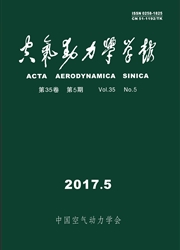

 中文摘要:
中文摘要:
采用数值模拟方法研究了不同流动参数对二元双喉道射流推力矢量喷管(Dual-throatfluidic Thrust-vecto-ringNozzle,DTN)内流特性和推力矢量控制效果的影响。结果表明,DTN在非推力矢量情况下,NPR在3~4范围时,推力系数较大,达到0.968,而流量系数较小,仅为0.93;NPR再增大,推力系数迅速下降。在推力矢量情况下,落压比一定时,随着次流流量比的增加,推力矢量角增加,而流量系数、推力系数、推力矢量效率减小;次流流量比一定时,随着落压比的增加,推力矢量角减小,系统推力系数先增加后减小,流量系数略微增加。
 英文摘要:
英文摘要:
Fluidic thrust vectoring technique is an advanced thrust vectoring concept, It has many potential benefits, such as light weight, control convenience, low manufacturing cost and high ratio of thrust to weight, comparing with conventional mechanical thrust vectoring tech- nique. The effects of several flow parameters on the internal flow of the dual-throat fluidic thrust-vectoring nozzle (DTN) are analyzed by numerical simulation method. The results indicate that DTN can provide high thrust vectoring efficiency with nozzle pressure ratio (NPR) of 3~4 (system thrust ratio arrives 0. 968, discharge coefficient 0.93) under non-vectoring thrust state. Increase in NPR decreases system thrust ratio rapidly. When NPR is constant, thrust angle in- creases with the increase in the secondary injection flux under vectoring thrust state. However, discharge coefficient, system thrust ratio and thrust vectoring efficiency will decrease simultane- ously. When the secondary injection flux is constant, thrust angle decreases with the increase in NPR, whereas discharge coefficient may increase lightly, and system thrust ratio first increases and then decreases.
 同期刊论文项目
同期刊论文项目
 同项目期刊论文
同项目期刊论文
 期刊信息
期刊信息
